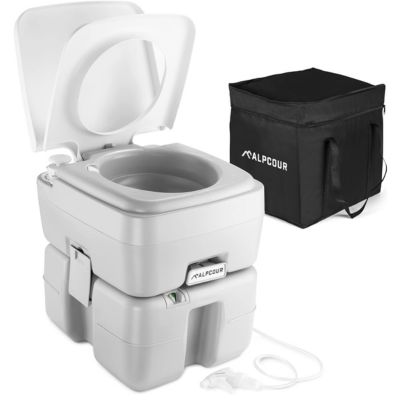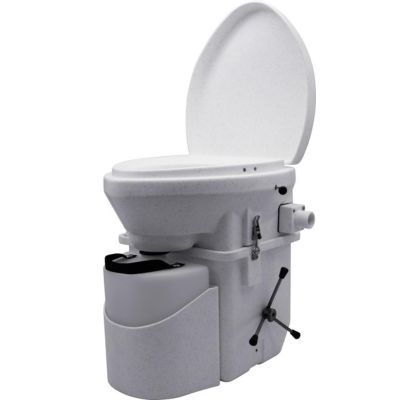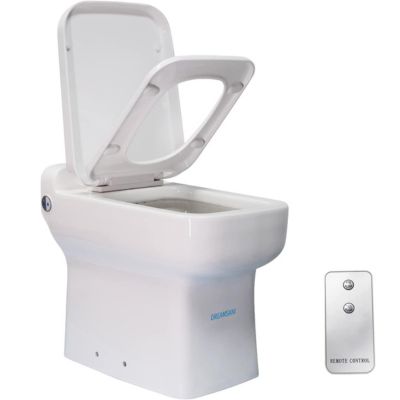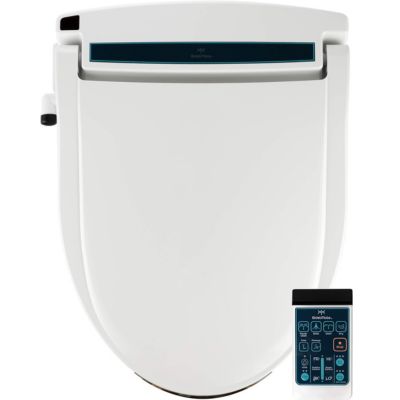Types Of RV Toilets
Anthony DayThis article may contain affiliate links where we earn a commission from qualifying purchases. The images and content on this page may be created by, or with the assistance of, artificial intelligence, and should be used for entertainment and informational purposes only.
Key Takeaways
- Understanding different RV toilet types is crucial for making an informed decision.
- The way an RV toilet processes and stores waste is an essential factor to consider.
- Personal preferences, camping style, and the size of your RV also influence your choice.
Exploring RV toilet types? Uncover the ideal fit for your travel needs with our guide, simplifying your selection journey.
For optimal RV convenience, choose Cassette for ease, Dry Flush for no water use, Composting for eco-friendliness, Incinerator for quick waste disposal, Portable for versatility, Macerating for effective breakdown, Gravity Flush for reliability, Vacuum for compactness, and Bidet for extra hygiene.
As an RV enthusiast with years of experience, I've explored every corner of this lifestyle, especially the often overlooked but crucial aspect of sanitation. Through countless journeys, I've gained a deep understanding of what works and what doesn't in maintaining comfort and hygiene on the road. The right choice can make all the difference in your travel experience.
RV Toilet Types: Your Practical Choice Guide to Comfort
RV toilet types might not be the most glamorous topic, but choosing the right one is crucial for anyone looking to embrace the RV lifestyle or upgrade their current setup. With various types of RV toilets available, each offering unique advantages and functionality, it's essential to understand the differences to make an informed decision.
One main factor to consider when selecting an RV toilet is how it processes and stores waste, as this aspect determines maintenance, disposal procedures, and the overall experience. Moreover, the type of toilet you choose is also influenced by factors such as your camping style, travel destination, personal preferences, and the size of your recreational vehicle.
By providing a concise overview of various RV toilet types, this guide aims to simplify the decision-making process and equip you with the knowledge required to make a well-informed choice.
Here's a table comparing the key features of different types of RV toilets:
1. Cassette Toilet
Alpcour Portable Toilet
Cassette toilets are a popular choice for RV owners, particularly in smaller rigs such as camper vans. These toilets offer a space-saving and convenient way to manage waste while on the road.
Key Features
- Compact design: Cassette toilets are designed to fit in small spaces, making them ideal for smaller RVs or camper vans.
- Portable waste tank: A removable waste tank, or "cassette," collects both liquid and solid waste.
- Easy to empty: The portable waste tank can be easily removed and emptied at dump stations or public toilets.
- Minimal water usage: Cassette toilets use minimal water, helping conserve the freshwater supply in your RV.
What Makes It Unique
Unlike traditional RV toilets, which connect to a larger, built-in black tank, cassette toilets have a separate, removable waste tank. This design allows for easier waste disposal, as you can simply detach the cassette, carry it to a dump station or public toilet, and empty it there. This can be a significant convenience for those who prefer to avoid sewer hose connections and dealing with raw sewage.
Pros
- A space-saving design ideal for smaller RVs
- Easier waste disposal compared to traditional RV toilets
- Low water usage
- Less maintenance is required than other types of RV toilets
- No need for special RV toilet paper
Cons
- Waste tank capacity is smaller than built-in black tanks
- May not be ideal for large groups or extended stays without access to dump stations
- Using cassette toilet chemicals is necessary to control odors and break down waste
Where to Buy
Cassette toilets can be purchased from various retailers, such as Amazon or specialized RV and camping supply stores. It's essential to compare different models and read customer reviews to find the best cassette toilet for your particular RV and preferences.
2. Dry Flush Toilet
Camping Brothers Portable Toilet with Carry Bag
A dry flush toilet is an RV toilet option that offers an alternative to traditional flush systems. It is an ideal choice for those who prioritize water conservation and ease of maintenance.
Key Features
- Waterless operation: Dry flush toilets do not rely on water to flush and clean the bowl.
- Special liners: These toilets use special toilet bowl liners to contain and seal waste after each use.
- Easy maintenance: Unlike some other types of RV toilets, dry flush toilets require minimal cleaning and maintenance.
- Portable: Dry flush toilets are typically lightweight and compact, making them suitable for smaller RVs and camper vans.
What Makes It Unique
The dry flush toilet stands out in the realm of RV toilets due to its waterless operation. It does not require a connection to fresh water or a black tank to function. Instead, it utilizes special liner bags that fit inside the bowl. After each use, the waste is sealed within the liner, making it easy to dispose of in a trash can later on.
Pros
- No water is used to flush the toilet, making it an environmentally friendly choice
- Sealed liner bags can be easily removed and discarded in a trash can
- There's no need to clean the bowl or deal with black tank maintenance
- Its compact design and lightweight nature make it suitable for various RV sizes
Cons
- Dry-flush toilet systems can be more expensive than other options
- Requires the continuous purchase and use of special liner bags
Where to Buy
Dry flush toilets can be found at various online retailers such as Amazon, as well as in specialty stores that cater to RV and camping enthusiasts. Keep an eye out for reviews and compare different brands to ensure you're making the best choice for your specific needs.
3. Composting Toilet
Nature's Head Self Contained Composting Toilet
Composting toilets are a viable and environmentally friendly option for RV users who want to minimize their ecological footprint. These toilets break down waste into a nutrient-rich compost that can be safely disposed of.
Key Features
- Environmentally friendly: These toilets don't use water, chemicals, or a separate waste tank, which reduces your impact on the environment.
- Low maintenance: You only need to replace the composting medium (usually coconut coir) periodically.
- Compact and space-saving: Ideal for smaller RVs or camper vans.
What Makes It Unique
Three main elements set composting toilets apart from other RV toilet options:
- Waste Separation: Composting toilets separate solid and liquid waste. This prevents the unpleasant smell that often comes with traditional waste-holding tanks.
- Composting Medium: Solid waste is mixed with a composting medium, such as coconut coir or sawdust, that helps break down waste and control odor.
- Ventilation: A fan or vent system helps evaporate liquid waste and maintain air circulation, reducing smell and keeping the toilet fresh.
Pros
- Saves water and reduces overall weight in your RV
- Waste is turned into valuable compost instead of being dumped into a sewer system
- Properly maintained composting toilets have little to smell
- This saves money and is better for the environment
Cons
- Composting toilets are often more expensive upfront than other types of RV toilets
- The urine tank needs to be emptied regularly, depending on usage
- Composting toilets require periodic maintenance
- Some users may not find composting toilets as visually appealing
Where to Buy
Composting toilets for RVs can be purchased online or at specialty RV shops. There are several popular models, such as Nature's Head, OGO Composting Toilet, and Air Head. Online retailers like Amazon also offer a variety of composting toilets, making it easy to find one that suits your needs.
4. Incinerator Toilet
One-piece Remote Control Macerating Toilet
An incinerator toilet is a waterless and environmentally friendly option for those who value ease of maintenance and efficient waste disposal in their RVs. This type of toilet does not rely on a traditional waste holding tank, making it an attractive choice for unconstrained RV living.
Key Features
- Environmentally friendly: Less waste and water usage
- High-temperature incineration (970 to 1,400 degrees Fahrenheit)
- Compact and durable design
- Convenient waste disposal: Ash residue
What Makes It Unique
The main feature that sets incinerator toilets apart from other types of RV toilets is the use of heat instead of water to dispose of human waste. Instead of relying on flushing, these toilets incinerate waste, turning it into sterile ash, which can be easily removed from the toilet's incineration chamber. This eliminates the need for a waste-holding tank and simplifies the process of maintaining a hygienic and odor-free RV bathroom.
Pros
- Less reliance on freshwater supply
- No black tank or sewage disposal required
- Turns waste into ash
- No chemical usage and low water consumption
Cons
- Electricity needed for the incineration process
- Requires manual emptying of ash residue
- Higher initial cost compared to traditional RV toilets
- The incineration process can be loud
Where to Buy
Incinerator toilets can be purchased from various online retailers such as Amazon or from specialized RV and camping equipment stores. Be sure to research different models and read customer reviews to find the best incinerator toilet that suits your needs and preferences.
Keep in mind that incinerator toilets are relatively expensive compared to other types of RV toilets, so consider your budget and overall RV lifestyle before making a decision.
5. Portable Toilet
Portable toilets are a convenient option for those who prioritize ease of use and space-saving in their RV. They are designed to be compact, lightweight, and easily transportable, which means they can be used not only inside your RV but also outdoors when going camping or exploring the wilderness.
Key Features
- Compact and lightweight design
- Easy to empty and clean
- Can be used both inside and outside the RV
- Ideal for camping and outdoor activities
- Suitable for smaller RVs and camper vans
What Makes It Unique
Portable toilets stand out among the different types of RV toilets because of their compact size and versatility. They are typically self-contained, which means they do not require any hookups or connections to a water supply or waste tank. This makes them perfect not only for RVs but also for other recreational activities such as camping, hiking, or boating.
Pros
- Easy to set up and use
- No need for an external water supply or waste-holding tank
- Perfect for camping and outdoor activities
- Space-saving design, suitable for smaller RVs or camper vans
- Less expensive than most built-in RV toilets
Cons
- Smaller waste capacity than built-in RV toilets
- Needs to be emptied and cleaned more frequently
- May not be as comfortable as traditional RV toilets due to their smaller size
Where to Buy
Portable camping toilets can be purchased at outdoor retailers, RV supply stores, or online platforms such as Amazon.
6. Macerating Toilet
Macerating toilets are a popular choice in the world of RV toilets, particularly due to their unique features and capabilities.
Key Features
- Macerating Pump: A macerating toilet uses a pump to break down waste into a slurry, which is then flushed into the black water tank.
- Efficient Water Consumption: These toilets require less water per flush compared to traditional RV toilets.
- Compact Design: Macerating toilets often feature a compact design that saves space in the RV bathroom.
What Makes It Unique
The main feature that sets a macerating toilet apart from other types of RV toilets is its macerating pump. This pump grinds and liquefies waste before disposing it in the black water tank. This process reduces the risk of clogs and makes it easier to empty the tank at a dump station.
Pros
- Lower water consumption
- Efficient waste disposal
- Reduced clogging issues
- Compact design suitable for small spaces
Cons
- Higher cost compared to traditional RV toilets
- May require additional maintenance
- Requires electricity for the pump to operate
Where to Buy
Macerating toilets can be purchased from various retailers, both online and in brick-and-mortar stores. For example, you can find RV macerating toilets available on Amazon.
Here’s a table showing some popular macerating toilet models
7. Traditional Gravity Flush Toilet
AW RV Camper Toilet Gravity Flush Toilet
In this section, we will discuss the traditional gravity flush toilet, which is a popular and commonly found type of RV toilet. These toilets function by utilizing gravity to move waste from the toilet bowl into the holding tank below, making them simple and reliable.
Key Features
- Gravity flush system: The gravity flush toilet relies on gravity to move waste from the toilet bowl into the black tank below.
- Maintenance: Generally low-maintenance due to its simple design.
- Comfortable: The traditional gravity flush toilet provides a familiar and comfortable experience for RV users.
What Makes It Unique
While there are many types of RV toilets, the traditional gravity flush toilet stands out for its simple and reliable design. Its main advantage lies in the straightforward gravity flush system, which allows waste to be easily transported from the toilet bowl to the holding tank without the need for complex mechanisms or powered assistance.
Pros
- Easy to use with minimal moving parts
- Familiar experience for those used to residential toilets
- Regular RV toilet paper can usually be used without complications
- Lower overall cost compared to other RV toilet types
Cons
- Requires a direct connection to a black tank for waste storage
- More susceptible to odors escaping from the holding tank compared with other types
- May require more water for efficient flushing
Where to Buy
The traditional gravity flush RV toilet is a common option for many RVers, and it can be purchased at various retailers specializing in RV accessories, such as Amazon. Additionally, many manufacturers and local RV dealerships carry a selection of gravity-flush RV toilets for you to choose from.
8. Vacuum Toilet
Kohree Portable RV Toilet
Vacuum toilets are a more advanced option for RV owners seeking cleanliness, low maintenance, and efficient use of space. These toilets utilize vacuum technology to flush waste into a waste-holding tank. Let's explore the key features, uniqueness, pros, and cons of vacuum toilets, as well as where to buy them.
Key Features
- Utilizes vacuum technology for efficient waste removal
- Low water usage
- Odor-free operation
- Compact design suitable for small spaces
What Makes It Unique
A vacuum toilet is unique among the types of RV toilets for its efficient use of vacuum technology to flush waste. They are similar to those found in airplanes, using vacuum pressure to completely flush waste with a very small amount of water. Reduced water consumption not only conserves freshwater supply but also lessens the frequency and amount of waste in the holding tank.
Pros
- It uses significantly less water than traditional gravity-flush toilets
- The vacuum seal helps prevent odors from escaping the waste-holding tank
- It is ideal for smaller RV spaces where bathroom size is limited
- Vacuum pressure ensures a thorough flush of waste into the holding tank
Cons
- Vacuum toilets can be more expensive than some other RV toilet options
- Due to their mechanism, vacuum toilets need a power supply to function
- Installation can be more complex compared to other types of RV toilets
Where to Buy
Vacuum toilets for RVs can be purchased from various online retailers, such as Amazon. Make sure to do thorough research and compare pricing, features, and customer reviews to find the vacuum toilet that best suits your needs and budget.
9. Bidet Toilet System
BidetMate 2000 Series Electric Bidet Heated Smart Toilet Seat
A bidet toilet system is an excellent choice for those who prioritize hygiene and comfort in their RV bathroom experience. These systems often require minimal maintenance and provide users with a more refreshing alternative to traditional toilet paper use.
Key Features
- Hygienic: Bidet systems use fresh water to clean, providing a more sanitary option for personal hygiene.
- Comfortable: The water spray offers a soothing and gentle cleaning experience.
- Low maintenance: There's no need to buy and store large amounts of toilet paper, reducing waste.
- Versatile: Many bidet systems are easy to attach to existing RV toilets.
What Makes It Unique
Bidet toilet systems differ from other RV toilets as they employ water for cleaning rather than solely relying on toilet paper. This feature is especially beneficial for those looking to save water and minimize waste, as well as provide a more satisfying cleaning experience.
Additionally, bidet systems generally have straightforward installation processes and can be easily removed if the user chooses to switch back to a traditional toilet setup.
Pros
- The use of water for cleaning provides a more sanitary experience
- The gentle water spray is refreshing and soothing
- Bidet systems help minimize waste and conserve resources
- Many bidet systems are designed to be compatible with existing RV toilets
Cons
- Not all RV toilet systems may be suitable for attaching bidet attachments
- In some cases, bidet systems may only provide cold water
- Adding a bidet system may not be feasible for all RV bathrooms
Where To Buy
To purchase a bidet toilet system for your RV, consider looking at online retailers such as Amazon. Before purchasing, make sure to read product reviews, compare prices, and check compatibility with your existing RV toilet system.
Important Things to Note Before Choosing an RV Toilet Type
Before choosing the right type of RV toilet, there are several key factors to consider. This section will help you determine what aspects are essential when selecting the best RV toilet for your needs.
- Space constraints: RV living often means working with limited space. It's essential to measure your available space before buying an RV toilet. Some options are compact and designed specifically for smaller RVs or camper vans.
- Maintenance and ease of installation: Consider how easy it is to maintain and install the toilet. Gravity flush toilets, for example, are generally easy to install and maintain. On the other hand, composting toilets require more upkeep but are environmentally friendly.
- Holding tank capacity: Each type of RV toilet uses a different method for handling waste. Traditional gravity flush toilets store waste in a black tank, which requires proper dumping at a designated dump station. On the other hand, composting toilets only require frequent disposal of solid waste. Consider how often you want to empty tanks and the availability of dump stations when choosing your toilet type.
- Environmental considerations: Some RV toilet types are more eco-friendly than others. Composting toilets, for example, require no water and help reduce waste. Vacuum and macerator toilets are also water-saving options. Consider your environmental impact when selecting an RV toilet.
- Type of waste disposal: The way each toilet disposes of waste varies depending on the type. Gravity flush models deposit waste in a holding tank, while composting toilets use a separate container to decompose and reduce waste. Cassette toilets use a removable storage tank for easy disposal. Consider how you plan to dispose of waste when choosing the right RV toilet type.
- Materials and comfort: Some RV toilets are made of lightweight materials like plastic, while others have porcelain bowls similar to household toilets. The choice comes down to your personal preference in terms of comfort and durability.























